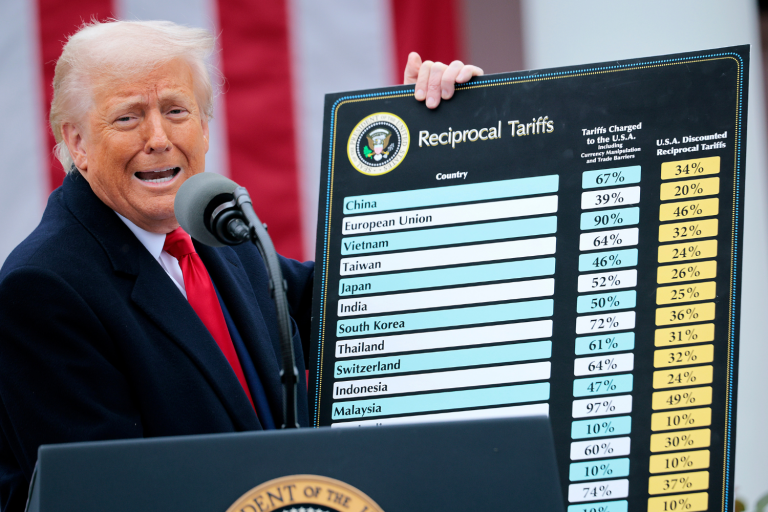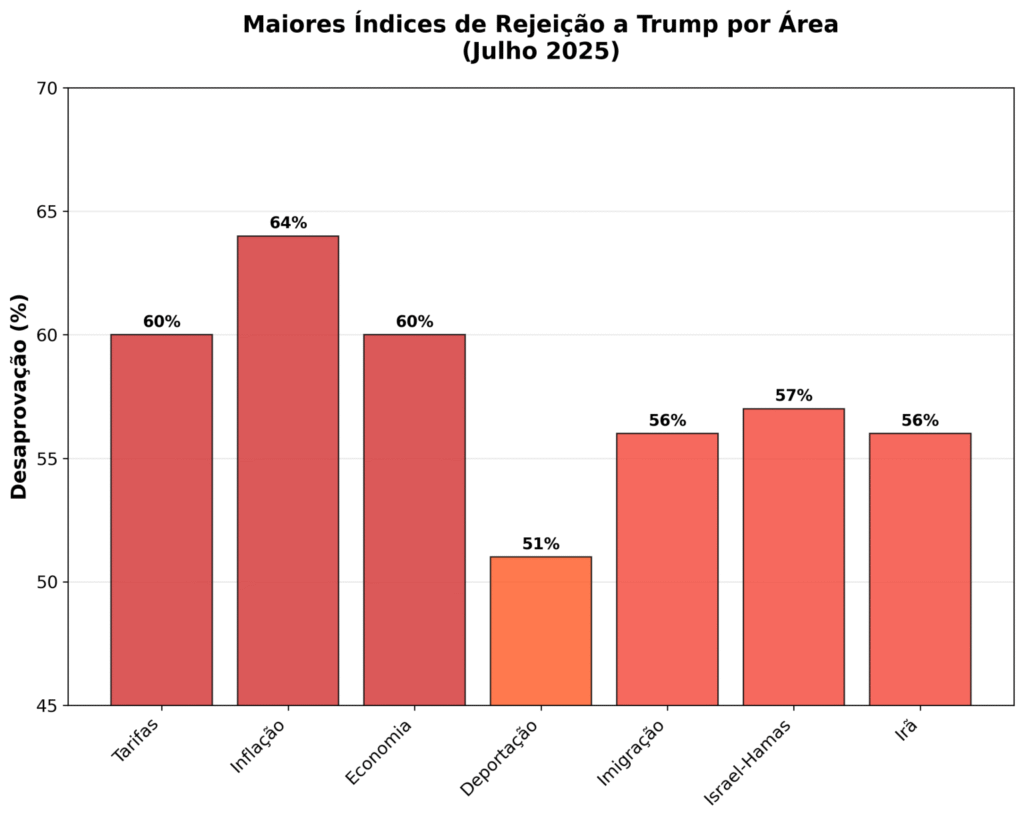
First poll after tariff war against Brazil reveals opposite effect for both presidents.
The first approval rating survey conducted after Donald Trump announced 50% tariffs against Brazilian products reveals a contrasting political effect for the two presidents. While Luiz Inácio Lula da Silva registers a significant increase in popularity in Brazil, Trump is heading in the opposite direction, with his approval plummeting 11 percentage points in five months.
The American president’s approval went from 53% in February to 42% in July, according to a new CBS News/YouGov poll released this Sunday. The American population has increasingly rejected the administration’s tariff policies, in a move that diametrically contrasts with the political strengthening Lula is experiencing in Brazil after the trade confrontation.
The numbers reveal a trajectory of constant decline: 53% on February 9, 51% on March 2, 50% on March 30, 47% on April 13, 45% on April 27, remaining at 45% on June 8, until reaching the current 42%. Each monthly measurement registered a drop or stagnation, without any period of recovery.

The survey, conducted between July 16 and 18, 2025, with 2,343 American adults and a margin of error of ±2.5 percentage points, shows that 58% of Americans now disapprove of the presidential performance. The intensity of the rejection is particularly concerning: 47% “strongly” disapprove of Trump, more than double the 24% who “strongly” approve of him.
The scenario becomes even more challenging when we analyze the general perception of the country’s direction. Only 38% of Americans believe things are going well, while 61% believe the country is on the wrong track. Among these, 38% believe things are going “very badly,” surpassing the 9% who believe they are going “very well.”
Trump and Tariffs: Unpopular Policy Worsens Rejection Scenario
Tariffs, one of the central policies of Trump’s economic agenda, face strong popular rejection that helps explain the drop in presidential approval. Three out of five Americans (60%) oppose the imposition of new tariffs on imported products, while only 40% favor them. This majority opposition represents a significant obstacle to one of the president’s main campaign promises.
The perception of an excessive focus on tariffs also hurts Trump. According to the survey, 61% of Americans believe the administration is focusing “too much” on imposing tariffs, while only 33% consider the focus “appropriate” and a mere 5% believe it’s not enough. The rejection of tariffs intensifies precisely as Trump escalates the trade confrontation with Brazil.
The lack of clarity in tariff policy also generates distrust. When asked if Trump has a clear plan for tariffs and trade, 57% of Americans respond that he “does not have a clear plan,” against 43% who believe the opposite. This perception of improvisation in a central area of economic policy undermines presidential credibility.
The contrast with Americans’ priorities is evident. While Trump focuses on tariffs, 70% of respondents believe the administration is not doing “enough” to lower prices of goods and services. Only 6% believe there is “too much” focus on reducing prices, highlighting the misalignment between presidential priorities and popular demands.
Economy and Inflation Weigh Against the President
Economic management emerges as one of the Trump administration’s main weaknesses. Only 40% approve of his performance on the economy, while 60% disapprove. The picture further deteriorates on the issue of inflation, where Trump records his worst performance: only 36% approve of his management, against 64% who disapprove.
Accountability for current economic conditions also weighs against Trump. When asked who is most responsible for the state of the American economy, 48% point to Trump’s policies, compared to only 23% who blame Joe Biden. This perception of direct responsibility negatively impacts presidential approval.
Americans’ personal financial situations reflect economic discontent. Half of the respondents (50%) state that Trump’s policies have left them “financially worse off,” while only 18% feel “financially better off.” Another 32% believe their situation remains the same.
The impact on food and basic goods prices is particularly severe. Two-thirds of Americans (62%) state that Trump’s policies are causing food and basic goods prices to rise, while only 16% perceive price reductions. For 56% of respondents, the issue of inflation and prices matters “a lot” in evaluating Trump’s presidency.

Deportation: Program Loses Popular Support
The deportation program, initially popular, is also facing erosion of support. Currently, 51% of Americans disapprove of the deportation program, while 49% approve it—a significant reversal from the beginning of the term when it had majority support.
The perception of deportation targets contributes to this change. More than half of Americans (52%) believe Trump is trying to deport “more people than they thought,” while only 11% believe he is deporting “fewer people.” This perception of excess in deportations fuels disapproval.
More concerning for the administration is the perception of deportation priorities. A majority of Americans (56%) believe Trump is prioritizing people “who are not dangerous criminals,” while only 44% believe he is focusing on “dangerous criminals.” This perception undermines the central argument of the deportation policy.
The use of detention facilities also faces strong opposition. Almost six out of ten Americans (58%) oppose the way the administration is using detention facilities, while only 42% approve.
Immigration: From Strength to Vulnerability
Immigration, traditionally a Trump strong point, now shows negative numbers. Only 44% approve of his handling of the area, while 56% disapprove. This change represents a significant transformation in public perception of one of Trump’s main banners.
The perception of the Republican approach to immigration has also changed dramatically. Currently, 53% of Americans believe Trump and Republicans are being “too harsh” on immigration, while only 18% believe they are not being “harsh enough.” Another 29% consider the approach “appropriate.”
This result represents a complete reversal from the Biden administration, when most Americans believed Democrats were not being “harsh enough” on immigration. The change illustrates how policies can generate pendulum swings in American public opinion.
The racial issue also emerges as a complicating factor. Two-thirds of Americans (64%), including Hispanics, believe that Hispanic people are being more targeted in immigration and deportation searches than people of other backgrounds. Among those who perceive this targeting, the majority consider the practice “unfair.”
Federal Reserve: Independence Versus Presidential Control
The relationship with the Federal Reserve also generates controversy. Although many Americans admit to knowing little about the Fed’s functions (49% know “little” or “nothing”), 68% believe the institution should make decisions “independently” of Trump, while only 32% believe it should be “guided” by the president.
Confidence in Fed Chair Jerome Powell is mixed. Only 38% express “a lot” or “some” confidence in Powell, while 34% have “little” or “no” confidence. Another 28% are unsure. The partisan division is evident: Democrats express more confidence in Powell than Republicans.
Foreign Policy: Challenges Persist
In foreign policy, Trump faces majority disapproval. In managing the Israel-Hamas conflict, only 43% approve of his approach, while 57% disapprove. Regarding Iran, the numbers are similar: 44% approval versus 56% disapproval.
These indicators suggest that even in areas traditionally favorable to Republicans, Trump faces significant resistance from public opinion.
About the survey: The CBS News/YouGov poll was conducted between July 16 and 18, 2025, with 2,343 American adults. The sample was weighted to be representative of the national adult population by gender, age, race, education, and 2024 presidential vote. The margin of error is ±2.5 percentage points.










